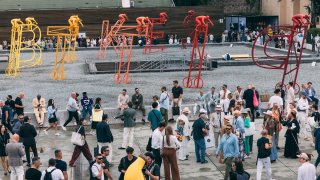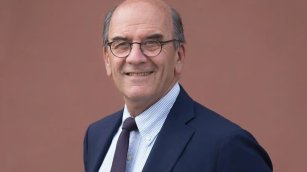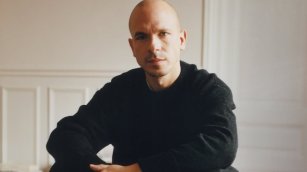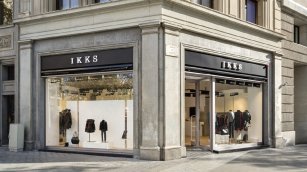Globalization and Spectacle Drive Pitti Uomo’s Strategy Through Uncertain Times
The Florentine fair closed its 108th edition with a slight increase in international buyers and a strong focus on foreign countries. The transport strike and the extreme heat set the pace of a show without euphoria.


Neither fireworks nor scaremongering. In a context marked by a slowdown in consumption, pressure on prices and a redefinition of the role of trade fairs, Pitti Uomo closed its 108th edition with a clear message: men's fashion still needs solid meeting points and Florence remains one of its benchmarks.
Faced with the "perfect storm" described in an interview with Modaes by Raffaello Napoleone, CEO of the Italian event, the fair responded with a full schedule of events, a lineup headed by international names and collectives and presentations at its headquarters, the iconic Fortezza, marked by original concepts and spectacular spaces to attract the gaze of visitors and buyers, who are increasingly in demand.
With a slightly lower number of exhibitors compared to previous editions, 740 brands, 45% of them international, the fair started with dynamism and its usual enthusiasm, boasting of being one of the events that best maintains its attractiveness in the industry.In spite of the first few hours of the fair, which brought the public together inside the pavilions, the dynamic did not falter: full aisles and generalized motivation to progressively surpass the figures prior to the pandemic.
"Being here today is a beautiful demonstration of courage and faith in what we do," said Antonio De Matteis, president of Pitti Immagine, at the opening presentation of the Florentine event. In the past financial year, Italian men's fashion achieved a turnover of €11.42 billion, compared to €10.14 billion in 2019, a drop of 3.6% compared to the previous year.
Pitti Uomo welcomed attendees with two large pavilions by Guess Jeans and Ecoalf
On the first day, featuring the grand return of Tommy Hilfiger to present his tailoring line or the now classic dinner of luxury brand Brunello Cucinelli, the brands highlighted the trend of mixing brand identity with strong concepts and experiences. The Fortezza da Basso became, once again this year, an advanced summer scenography, where brands bet on the show as a tool of attraction.
At the entrance, the huge blue pavilion of Guess Jeans not only presented its new washing technologies developed together with the Spanish Jeanologia, but also proposed a new space for personalization and customization of denim bags. "We wanted to replicate the experience that our customers can have in stores, we are a young line that is growing a lot but we still have to make known our differentiation with respect to Guess and Pitti is the best place to do it," said those responsible for marketing the brand in the Italian market. The brand, with a more accessible positioning than its big sister, already has flagship stores in Milan, Berlin and Amsterdam, and will soon arrive in Tokyo.
Right next to it, the Spanish Ecoalf occupied an imposing exhibition space in the form of an individual pavilion in which to introduce its novelties. We have become one of the brands representing sustainability par excellence at Pitti Uomo," said marketing manager Carolina Álvarez-Ossorio about the privileged location.
"Being present at this fair for years is key in terms of image and international contacts," she acknowledged, underlining the importance of the Italian market in Ecoalf's future plans. There, the sustainable company already operates stores in Milan, Turin and Rome. Javier Goyeneche's brand, which has just set up shop in Biarritz and aims to have a turnover of €70 million by 2025, has made the development of its retail business in Italy and Germany the focus of its interest.
Ellesse, Kiton and Sun68 have opted for spectacular staging, dominated by the bicycle theme
Beyond the two brands that welcomed the attendees, as the public entered the venue characterized by its large open spaces, the professional staging took over the presentations. The stands and pavilions bordered on the theatrical, leaving the more classic trade fair proposals far behind. If the Sun68 brand transformed its space into an Italian pizzeria, MC2 Saint Barth transformed it into a Greek tavern with live music and Roy Roger's turned its stand into a pilgrimage point thanks to its collaboration with the historic Florentine ice cream maker Vivoli, serving affogatos at a constant rhythm.
In the case of Kiton, the bet was even more ambitious: sand, a huge Strider 13 boat and the launch of its nautical capsule KNT Marina. Likewise, at a time when trade fairs are rethinking their positioning to continue to justify their raison d'être, Pitti Uomo was not only limited to its incessant and improvised parades of dandies exquisitely sheathed in suits and hats; but the sensory experience was also extended to the common areas, with umbrellas, sun loungers and omnipresent music.
The edition was also marked by a sporting spirit, with cycling as the show's conceptual axis. The debut of the Becycle space, part of the I Go Out sports section, brought together brands such as Colnago, Passoni and Pas Normal Studios, which paraded on bicycles around the outdoor areas of the show. At the same time, Ellesse caught all eyes with a gigantic tennis court where tournaments were held with extra-large rackets and balls, reaffirming Pitti's commitment to the show as an engine of attraction in times of commercial uncertainty.
Between June 17 and 20, more than 11,400 buyers (5,400 of them from abroad) passed through the Fortezza da Basso, representing a 3% growth in the presence of oxen compared to June of the previous year. In addition, the Florentine show raised the total number of visitors to over 15,000. The upturn in international buyers, with a strong presence from the United States, China and emerging markets such as India, Brazil and Kazakhstan, at the same time offset the slight drop in the number of Italian visitors.
The heat and the transport strike complicated the attendance traffic in the last days of the fair
"Pitti Uomo is both a symbol and a concrete tool for the promotion and development of trade, even in phases of transition like the one we are probably going through now," noted Raffaello Napoleone, CEO of Pitti Immagine. "And the response from buyers, arriving from more than a hundred countries on five continents, has been the best we could have hoped for," he added.
The executive also highlighted the good performance of the non-European markets, highlighting the impulse of the groups coming from China and Korea; as well as the return of professionals from regions that had been absent for several editions, such as Australia, the Middle East or Central Asia. The Nordic market also made its presence felt in the dedicated space, christened Scandinavian Manifesto, a Scandinavian collective of fashion, accessories and beauty brands that managed to attract the attention of a good number of international buyers.
"Some of the firms have been attending for several years, but others are a discovery for buyers looking for the total look," said the organizers, celebrating the positive reception of the collective promoted by the Danish fair Ciff, which will hold its next edition in August.
After a second day of great dynamism in the corridors of the fair, despite the high temperatures, the movement slowed down on Thursday and Friday, accusing the effect of the national transport strike, which forced many attendees to bring forward their return home ... or to Milan, where fashion took the baton with the celebration of a men's fashion week with a decaffeinated agenda marked by the lack of big names.
The last edition of the Florentine fair brought together more than 11,400 buyers
Among the brands, the joy was divided into different neighborhoods. Many names celebrated the positive atmosphere of the Florentine show and the effervescence of business during the first days, while many companies, generally those of smaller size for which the investment in participation is a greater effort, lamented the quietness of the aisles, pointing to an edition with a lower number of attendees.
In the absence of major commercial headlines, at least for the moment, the show was committed to consolidating its position as a global menswear showcase, expanding its international collaborations and reinforcing the experiential component. However, behind the scenes, some industry voices noted that enthusiasm is not unanimous: although the atmosphere was dynamic at the start and the calendar of events solid, doubts persist about the real profitability for certain brands and how to capitalize on the visibility beyond the media impact.
Beyond the show, the real challenge for the fair and for the entire menswear system now lies in translating this energy into business. In an increasingly fragmented and competitive scenario, not all players are starting from the same starting point.














